|
|
|
|


INARI / Oinari / Oinari-sama
Shinto God/Goddess of Rice & Food
Messenger = The Fox 狐 (Kitsune)
Origin: Hindu, Chinese, and Japanese Mythology
Inari 稲荷. The deity of rice and a major Shinto kami. Closely associated with various Shinto deities of food, Inari can be depicted in either male or female form. Inari not only protects the rice harvest -- s/he is also the patron of prosperity for farmers and merchants, especially those involved in rice production, foodstuffs and fisheries.
Inari is generally associated with various manifestations of the Hindu goddess Dakini or Dakiniten 荼枳尼天, who in turn is associated with Daikoku-ten 大黒天 (Skt. = Mahakala), the latter considered the Hindu god of Five Cereals. In Japan, Daikoku-ten is one of Japan’s Seven Lucky Gods and venerated as the luck-bringing protector of the earth, farming and farmers, commerce, and overall good fortune. Daikoku imagery in Japan is also identified with the mythic Shinto figure Ō-kuninushi-no-Mikoto (or Okuninushi-no-Kami, 大国主命, translated as “Prince Plenty” or “Prince Ruddy Plenty”), another Shinto deity of rice.
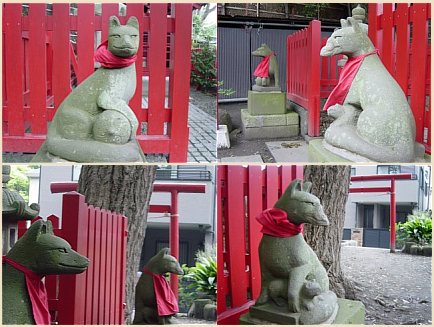
The Fox is Oinari’s messenger (tsukai 使い)
Fox Guardians near Tsurugaoka Hachimangu Shrine in Kamakura
Inari’s Messenger is the Fox
In traditional artwork, a pair of foxes typically flank Inari’s image. But in modern times, images of Inari have all but disappeared, replaced instead by images of Oinari’s messenger, the magical shape-shifting fox (kitsune 狐). Here the symbolism is two-fold. First, rice is sacred in Japan, closely associated with fertility (the pregnant earth) and with sustaining life. Inari and Inari’s foxes must therefore be placated -- otherwise it would be disastrous to the livelihood of the nation’s farmers and people.
Second, the fox is associated with the concept of Kimon 鬼門, literally “demon gate,” a Japanese term stemming from Chinese geomancy (Ch: feng shui). In Chinese thought, the northeast quarter is considered particularly inauspicious. It is the place where "demons gather and enter." This belief was imported by the Japanese and is referred to as Kimon. Kimon generally means ominous direction, or taboo direction. In Japan, the fox is considered a powerful ally in warding off evil Kimon influences. Fox statues are often placed in northeast locations to stand guard over demonic influence, and two foxes typically guard the entrance to Inari Shrines, one to the left and one to the right of the gate.
NOTE: In some Buddhist-Taoist sects in Japan, the role of warding off evil kimon is played by the monkey, as the Japanese term for monkey (猿, pronounced saru) is a homonym for the Japanese word "expel" (去る, also pronounced saru).

|
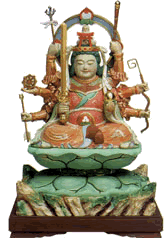
Uga Benzaiten
Photo Courtesy
telemesse.ne.jp/
daikakuji/0.html
|
|
 Inari in Shinto Lore Inari in Shinto Lore
Inari lore is quite complex and confusing. In early records, Inari is identified with Uga no Mitama no Kami, the Shinto goddess of agriculture, and also with a male counterpart named Uka no Mitama no Mikoto (the deity of grains, who was perhaps fathered by Susano-o?).
Inari is also associated with the food goddess Ukemochi no Kami (aka Ogetsu hime no kami). Ukemochi and Ogetsu appear in the literature of the early 8th century. Despite their different names, the two share common attributes and are probably manifestations of the same deity. One tradition says that Inari was married to Ukemochi / Ogetsu. When she was killed by the moon god Tsuki-yomi, Inari stepped in to replace her as protector of the rice crop.
The situation gets more confusing, for depictions of Inari vary greatly. Pre-modern artwork depicts Inari as a bearded man standing on a sack of rice with two fox flanking his sides, or as a long-haired woman carrying sheaves of rice or riding a white fox (see next two photos below; Jp. = myobu ??). Yet another deity, Uga Benzaiten, incorporates both Shinto and Buddhist attributes and fulfills many of the same roles as Inari. During Japan’s Heian era, the powerful Tendai sect on Mt. Hiei merged the Hindu-Buddhist female deity Benzaiten 弁財天 with an obscure local kami (spirit) named Ugajin to create the syncretic deity known as Uga Benzaiten 宇賀弁財天, a deity of good fortune and wealth. Most sources believe Ugajin is none other than Uga no Mitama, the Shinto goddess of foodstuffs mentioned above. Uga no Mitama is also commonly identified with a male counterpart named Uka no Mitama, the deity of grains. This Shinto pair are further identified with Inari (this page), the god/goddess of rice and agriculture. Confused yet? Lump them all together, and you have the composite Buddhist/Shinto deity called Uga Benzaiten. For much more on Ugajin, please see the Kokugakuin University database. For more details in Japanese, visit this outside site.
WHITE COLOR
Curiously, Inari 稲荷 (this page), Uga Benzaiten 宇賀弁財天, and Daikoku-ten 大黒天 (Hindu God of Five Cereals, identified with Japan’s Shinto Oo-kuninushi-no-Mikoto 大国主命) each have messengers that are WHITE in color. Inari is often associated with a white fox, Benzaiten with a white snake, and Oo-kuninushi with a white hare. Is this coincidental, or does it suggest a deeper relatedness? I believe it suggests a deeper pattern of shared iconography and origin.
INARI & DAKINI
As the Japanese god of rice and food, Inari is generally associated with various manifestations of the Hindu goddess Dakini or Dakiniten 荼枳尼天, who in turn is associated with Daikoku-ten 大黒天 (Skt. = Mahakala), the latter considered the Hindu god of Five Cereals. Says "Japan as It Is: A Bilingual Guide," published by Gakken, 1990. “Formerly a god of cereals worshipped in Fushimi on the outskirts of Kyoto, Inari was later merged with the Buddhist guardian deity Dakini who was generally depicted riding a fox. This and the traditional reverence of the common people for the fox are probably behind Inari's close association with the animal. Miniature Inari Shrines marking sacred sites are common. They are distinguished by their smallness, bright red gates (torii), and fox figure or figures. Deep-fried bean curd, abura-age, is thought to be a favorite food of the fox.” <end excerpt>
Dakini is a powerful Buddhist goddess from the Vajrayana (Tantric) tradition, who is sometimes associated with the Hindu goddess Kali. Called the Goddess of Life’s Turning Points, Dakini is today worshipped mainly in Tibet, and she can come in multiple manifestations. Dak (Sanskrit) means to beckon with sound, to call, to knock. Ini (Sanskrit) is attached to word stems to indicate female gender. Another similar theory is that Inari was syncretized with “Dakini-ten.” In Japan, Dakini-ten are the various manifestations of Dakini, and are generally associated with Daikoku-ten (Mahakala), who is considered the Hindu god of the Five Cereals (later becomes god of Buddhism, and today is one of Japan’s Seven Lucky Gods). This dakini had as its "messenger" a white fox, and worshippers offer fried soybean curd at Inari shrines, for this is apparently the favorite food of the fox.
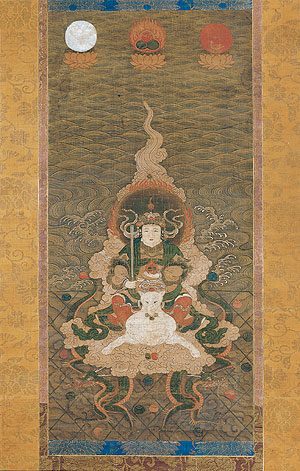
Dakiniten, Nambokucho period (1333–92 AD)
Japanese, Hanging scroll; ink, color, and gold on hemp
29 1/2 x 13 in. (74.9 x 33 cm)
Purchase, Friends of Asian Art Gifts
In honor of Wen C. Fong, 2000 (2000.274)
Photo from The Metropolitan Museum of Art (New York)
Above Photo, Below Text
Courtesy The Metropolitan Museum of Art
Description. As though a sudden apparition, a female deity in fluttering raiment splashes up a frame of foam on a billowing sea. Riding a white fox on a cloud held aloft by a pair of dragons, she clenches a vajra (thunderbolt) surmounted by a sword, a symbol of Buddhist power. In her palm she cradles a triad of sacred jewels, and others are scattered around her as abundant blessings. In her crown are auspicious protectors of the harvest: diminutive foxes on coiled white snakes, like those that encircle her wrists. Above, another triad of sacred jewels rests on an open lotus, flanked by Chinese symbols of the complementary forces of sun and moon.
This transformation of the wrathful Hindu deva Dakini emerged within Esoteric Buddhism in Japan. Originally a man-eating demoness, she was converted by the Vairocana (Dainichi) Buddha into a powerful life-engendering deity. In the complex interaction of Buddhism, Shinto, and Taoist yin-yang practices in medieval Japan, this icon embodied near-magical powers of fecundity that were invoked not only in enthronement rituals but also in personal contexts. The mantra identified with this deity was chanted to achieve control over the mind. Medieval tales recount invocations of Dakiniten by both men and women to win position and favor at court, as well as in matters of the heart. <End MET Entry; Written by Barbara B. Ford>
Says JAANUS: According to the Dainichikyousho 大日経疏, Dainichi Nyorai 大日如来 appears as Daikokuten in order to subdue Daikiniten 荼吉尼天. It appears that Daikokuten came to be a protector of food supply because images of him were placed in monastery kitchens in India and in China. In Japan this practice is said to have been begun by Saichou 最澄 on Mt. Hiei 比叡. Later Daikokuten became more closely associated with food and good forture. This tendancy was reinforced by his identification with the Shinto 神道 deity Ookuninushino Mikoto 大国主命.
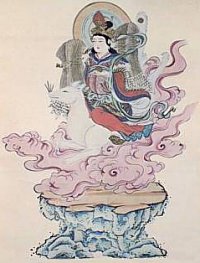
Japanese Dakiniten on White Fox
Modern. Source Unknown.
Found at this J-Site
For more details on Inari’s Dakini origins, click here.

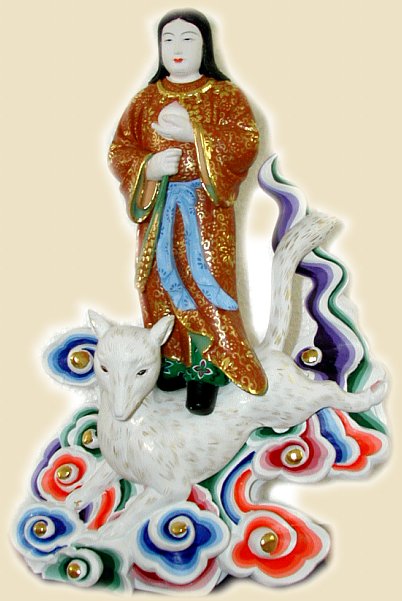
Modern Japanese Ceramic Statue
Found statue at online Japanese estore
http://kyokanze.ocnk.net/product/706

 THE FOX SPIRIT THE FOX SPIRIT
Kitsune 狐 = Fox
By the 11th century, for reasons hard to discern, Inari becomes intricately associated with the fox. In Japan, the fox is a legendary creature with supernatural powers for doing both good and evil. Able to transform into human shape (typically that of a bewitching woman), and to hear and see all secrets of humankind, the fox is Inari’s messenger. Even today, fox statues are found in great number inside and outside the thousands of Japanese shrines dedicated to Inari (some 20,000 Inari shrines nationwide; some sources say 30,000). Characteristics of Inari shrines are red torii (gates) protected by a pair of fox statues, one on the left and one on the right. The fox, moreover, is associated with the concept of Kimon 鬼門 (a Japanese term stemming from Chinese geomancy; literally “demon gate”). Kimon generally means ominous direction, or taboo direction, and can be most accurately translated as "demon gate to the northeast," or the "northeast place where demons gather and enter." The fox, like the monkey, is able to ward off evil kimon, and therefore the fox, in Japan, plays the role of guarding the demon gate to the northeast. Chinese concepts of geomancy (i.e., feng shui) are discussed here.
Although the lore of fox magic was introduced to Japan from China and Korea, it originated in India. Nonetheless, the supernatural powers of the fox are not exclusive to Asia, for fox mythology exists -- quite independently -- in many non-Asian nations as well.
  
Inari Shrine (stone) at private home in Kamakura
Inari Shrines are invariably guarded by statues of foxes
|
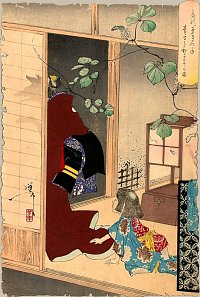
Fox-woman Kuzunoha Leaving Her Child; woodblock by Yoshitoshi Tsukioka 月岡 芳年 from his “New Forms of 36 Apparitions;” 1889-1892. STORY. A fox in human form marries a Japanese man, and soon gives birth to a child. But ultimately her true identity is discovered, and she must depart. In above print (courtesy this outside site), her silhouette behind the door makes it clear she is a fox, not a woman. For an interesting review of a similar story, and the origin of the word KITSUNE, click here (outside link).
|
|
 FOX LORE (Henge or Shape Shifters) FOX LORE (Henge or Shape Shifters)
Animals with the power of transformation -- for either benevolent or malevolent purposes -- are called henge. In Japanese folklore, the kitsune (fox) and tanuki (racoon dog) are masters of transformation, as is the Tengu, the bird-man goblin of the forest and mountain. Some say the fox and tanuki are only manifestations of the powerful Tengu, who is reverred as the slayer of vanity and pride.
Kitsune, or fox, grow in power as they age. After a century, they grow a tail and gain the ability to shape-shift and possess people. The most powerful foxes are those who reach the grand old age of 1,000 (the so-called nine-tailed fox). When a kitsune gains nine tails, its fur becomes silver, white, or gold, and it gains the power of infinite vision.
In Korea, a fox that lives a thousand years is said to turn into a kumiho (literally “nine-tail fox”), but the Korean fox is always depicted as evil, unlike the Japanese fox, which can be either benevolent or malevolent. Click here for more on the Korean fox.
Kitsune are renowned tricksters. In many Japanese folk tales, the kitsune appears in the form of a bewitching woman who seduces and tricks unworthy men or rewards and protects deserving people. In human disguise, the she-fox can breed with a man. Fox folk can also cast illusions, appear in dreams, and read thoughts.

GHOSTLY ZOOLOGY
The subject of the Japanese fox is so voluminous that Lafcadio Hearn has described it as “ghostly zoology.” Below are just some of the myriad myths about this creature, followed by a list of resources for those who would like to dig deeper.
- Kitsune Tsuki (Fox Lunacy) means demonic possession by a fox spirit, and according to legend it occurs mostly in women. Indeed researchers at the Imperial University of Japan in the early part of the 20th century seriously suggested that the fox spirit typically enters women of the lower classes (those most prone to superstition) through the breast or between the fingernails (from p.94 of F. Hadland Davis “Myths and Legends of Japan”).
-
|
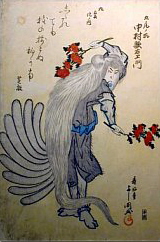
Nakamura Utaemon II as a Nine-tailed Fox; woodblock by Yoshikuni; from Charles Hovey Pepper collection
|
|
 Shape-Shifting Powers. While the kitsune’s preferred shape is that of a beguiling female, the fox is not limited to human forms. It can transform itself into any natural thing (e.g., it can turn into a tree, a rock, water, another animal). In the story “The Meanness of Raiko,” Inari himself assumes the shape of an enormous bloodsucking spider to frighten a mean but rich old man into changing his miserly ways. This story is a bit confusing, for Inari should not be transforming -- that is the work of Inari’s messenger, the fox. Alas, the lines between the deity Inari and his messenger, the fox, have become very blurred. The Japanese have even build shrines dedicated to the kitsune rather than Inari. Shape-Shifting Powers. While the kitsune’s preferred shape is that of a beguiling female, the fox is not limited to human forms. It can transform itself into any natural thing (e.g., it can turn into a tree, a rock, water, another animal). In the story “The Meanness of Raiko,” Inari himself assumes the shape of an enormous bloodsucking spider to frighten a mean but rich old man into changing his miserly ways. This story is a bit confusing, for Inari should not be transforming -- that is the work of Inari’s messenger, the fox. Alas, the lines between the deity Inari and his messenger, the fox, have become very blurred. The Japanese have even build shrines dedicated to the kitsune rather than Inari.
The shape-shifting power of the fox is not perfect. While transformed, the fox is vulnerable to the same pressures and natural preditors faced by the form it assumes.
Nor can the fox fully hide its disguise. In many tales, the true identity of a she-fox is discovered by viewing her reflection in a mirror or in water -- the reflection reveals a tail ! Dogs are a better defense against the fox spirit, for a fox-woman loses her human form when spotted by a canine.
- Inari as patron of sword smiths. Munechika, a famous sword maker, was ordered to make a sword for the Emperor, so he visited an Inari Shrine to pray for help. As he prayed, Inari appeared and helped him construct a sword of superb beauty. (Story from a Japanese Noh play)
- Hoshi-no-tama (star ball). Kitsune closely guard a round ball. Those who obtain it can force the kitsune to help them; one theory says that the kitsune ”reserves” some of its magic in this ball when it shape shifts. Kitsune must keep their promises or suffer a deterioration in their rank and power.

-
|
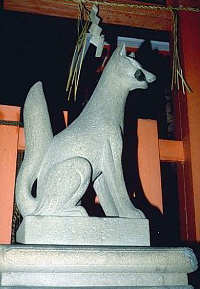
Fox with Granary Key in Mouth
Photo Courtesy Angus McIntyre
Kyoto; www.raingod.com
|
|
 Why the Fox Connection? Why the Fox Connection?
According to Kasama Inari Shrine
www.kasama.or.jp/english/top/no6.html
In ancient Shinto, the "mountain kami" was believed to descend from its winter residence in the mountain to become the "paddy field kami" (ta no kami) in the spring, residing there during the subsequent agricultural season. Following the fall harvest, the deity would return once again to its winter home in the mountains in its role as the "mountain kami." All this probably took place at the same time that foxes appeared each season. As such, the fox naturally became known as the messenger of Inari.
According to
Tim Screech at mangajin.com
Once very common throughout Japan, foxes were nevertheless seldom seen since they moved at night; dead birds, broken fences and chicken's blood were the only evidence of their nocturnal passages. It may have been the difficulty of seeing a fox, or of keeping it in view for any period of time, which led to the notion that they undergo actual physical shift. A fox might skulk into the farmyards looking like a fox, but exit in an entirely different form -- as an old woman, a boy, a demon, or a princess. In Japanese lore, they live a sort of mirror image of human society, with fox lords and ladies, servants and laborers -- standing on hind legs, dressed in human clothes, and carrying out their mystic rituals by lantern light in the middle of the forest. To the end of mitigating the powers that these worrisome animals possessed, shrines were erected, and the fox-god, Inari, became the most popular roadside divinity, honored with a clap of the hands on passing by, or with a gift of flowers, sake, or fried tofu (aburage, believed to be a favorite food of foxes). Even today, it is common to see a little street-corner shelter with a ceramic fox image housed behind a grill, offerings carefully placed in front to ward off all dangerous eventualities. Foxes have to be placated, for they are potentially disastrous to the livelihood of the farmer. They are also constant and salutary reminders of the fox-like characteristics that lie at the root of human behavior as well.
- Kimon 鬼門
The fox is sometimes associated with the concept of Kimon (a term stemming from Chinese geomancy, or Feng Shui), for the fox has the power to ward off evil kimon. Kimon means ominous direction, or taboo direction, and can be loosely translated as “gate of the devils to the northeast,” or “place where demons gather and enter.” The key concept is that the northeast direction is an unlucky direction, and very few houses are built with the entrance facing the northeast. The unlucky northeast direction is also sometimes referred to as “omote kimon,” or outer demon corner. Feng Shui is called Fusui in Japanese.
- Inari Shrines. One of the oldest Inari shrines is Fushimi Inari Taisha in southeast Kyoto (est. 8th century). Some sources say there are more than 20,000 shrines nationwide devoted to Inari. Inari is celebrated in a Shinto festival during the first days of spring when cultivation starts.
- WWII (told by Kagari Ando). During the hardship years surrounding World War Two, people in the city of Kyoto held seance sessions to invoke the aid of Inari. A Ouiji-like board was made by placing Japanese alphabet cards on the floor. In the center of the cards was an odd contraption -- three chopsticks standing upright, leaning against each other, like a teepee, and inside the three-pronged conjunction at the top was placed an ochoko (drinking cup). Gathered round, those present begin chanting Inari’s name. A question is asked (e.g., is my son still alive), more chanting to Inari, and then magic -- the chopstick structure begins to move, spelling out the answer my moving atop the alphabet cards.
- Kitsune no Yomeiri
When it rains while sun shines, people says "Kitsune no Yomeiri," which means Kitsune's Wedding. It is said that if you look carefully, you can see the wedding procession of Kitsune's bride in the distance.
- http://www.asianart.com/articles/rubin/
A black fox is good luck, a white fox calamity; three foxes together portend disaster. Buddhist legend tells of 'kitsune’ who disguise themselves as nuns, and wear traditional robes (depicted in Netsuke figurines). Fables tell how the fox likes to appear as women. Stories tell that while the ‘kitsune’ is in such a guise, he goes about tricking and misleading men into seduction. When the seduced come to the realisation of the true identity of their supposed love, the fox disappears. Legends tell of how ‘Kitsune’ can hypnotize people and lead them into perilous situations. To do this, according to the tales, they illuminate the path leading to such disasters, and this illumination is known as a "foxflare" (kitsune bi).

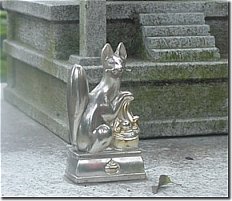 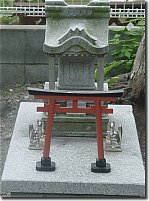
Miniature Inari Shrine outside Raikoji Temple, Kamakura
|
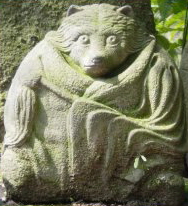
Stone statue at Zuisenji, Kamakura
Looks like a fox, but probably a tanuki.
Writes site visitor Michael: This appears to be a tanuki, not a fox, because of the creature's enormous girth, typical of tanuki in traditional art, and because of the slightly confused expression on its face (tanuki are not thought to be very bright) !
|
|

Inari, wood figurine, Tokugawa Period (1603-1867)
Courtesy Musée Guimet, Paris, where figurine is located
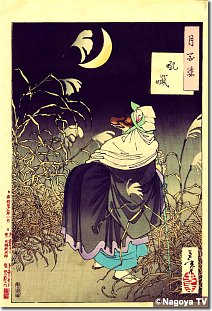
Cry of the Fox (#13)
from One Hundred Phases of the Moon (1886)
by Yoshitoshi Tsukioka
www.nagoyatv.com/ukiyoe/moon/moon.html

SHINTO DEITIES OF FOOD AND RICE
Below text largely from Inari Sho’s www.inari-art.com
Uga no Mitama no Mikoto. The spirit of food. Also known as INARI or INARI SAMA. This name signifies a load of rice, and it is said to have been given as a posthumous honour to the legendary man, UGA, who first cultivated rice, and is specially honoured at Inari no Yashiro. Tradition has it that the monk Kobo Daishi met an old man carrying on his back a rice sheaf, in 811, near Toji, and recognised in him the Deity protector of his temple. He then called this Deity, Inari (rice bearer). It is thought that some misconception or some confusion, due to the name MIKITSUNE UGA NO MITAMA, has caused the identification of the August Spirit of Food Deity, or God of rice, with a Fox divinity, and its association with the Fox (Kitsune), sometimes described as his messenger, and generally represented seated at the door of the temples of Inari. In fact, Inari Sama is often described as the Fox God, and is usually shown in the guise of a bearded old man carrying a sheaf of rice, accompanied by, or seated upon, a white fox. KODOMO NO INARI is the children's Fox God. In the first horse day (Uma no I) of February, country boys make little flags with papers of various colours, red, yellow and blue, and write the name of Inari on them, and offer them to the temple. INARI is also worshipped on the Fuigo matsuri, or Festival of the Bellows (November 8th), held in honour of Hettsui no kami, Goddess of the Kitchen. INARI must not be confused with KAMIYA (q.v.). It is also worshipped as a healer, a giver of wealth, and even sometimes as a protective divinity of the Joro class. <Source: Legend in Japanese Art, 1908. View this book online at the Internet Archive.>
Ukemochi appears in the Nihon Shokki (Chronicles of Japan), Ogetsu in the Kojiki (Records of Ancient Matters), both documents from the early 8th century. Although they have different names, the two appear to be manifestations of the same kami.
Ukemochi, Ukemochi no Kami. Japanese Goddess Who Possesses Food. In Shinto mythology, the goddess of food. Also sometimes identified as Wakaukonome (Young Woman with Food) and is associated with Toyuke (Toyouke) Okami, the god of food, clothing, and housing, who is enshrined in the Outer Shrine of Ise. She was killed by the moon god Tsuki-yumi when she offended him by vomiting large amounts of food. From her dead body emerged various animals (a horse, an ox, a silk worm, etc.), as well as rice, beans, etc. Her attributes are often absorbed into those of Inari.
According to the legend recounted in the Nihon Shoki (“Chronicles of Japan”), the moon god, Tsukiyomi, was dispatched to earth by his sister, the sun goddess Amaterasu, to visit Ukemochi no Kami. (According to the Kojiki, “Records of Ancient Matters,” it was another brother, the storm god Susanoo, who was sent on the mission.) The food goddess welcomed him by facing the land and disgorging from her mouth boiled rice, turning toward the sea and spewing out all kinds of fishes, and turning toward the land and disgorging game. She presented these foods to him at a banquet, but he was displeased at being offered the goddess’s vomit and drew his sword and killed her. When he returned to heaven and informed his sister of what he had done, she became angry and said, “Henceforth I shall not meet you face to face,” which is said to explain why the Sun and Moon are never seen together.
Another messenger sent to the food goddess by Amaterasu found various food stuffs produced from her dead body. From her head came the ox and the horse; from her forehead, millet; from her eyebrows, silkworms; from her eyes, panic grass (a cereal); from her belly, rice; and from her genitals, wheat and beans. Amaterasu had the food grains sown for humanity’s future use and, placing the silkworms in her mouth, reeled thread from them, thereby beginning the art of sericulture - the production of raw silk.
Myth: "Now, the name of the third deity who ruled these "eight islands" (Yashima) was Toyokunnu. Having assumed the heavenly command, he divided the descendants of the gods into the three ranks of kimi (sovereigns), tomi (ministers), and tami (the people), each with its special role in the organization of the country. "Toyokunnu had a younger brother named Ukemochi. While Ukemochi was praying to Amemiwoya (the "parent deity") one day in his fervent wish to bring prosperity to the people, his wish was granted when hiyouru seeds fell to earth. The hiyouru seeds contained the spirit of the sun and moon. When Ukemochi planted these seeds in a wet field, they grew into rice seedlings. And when the first day of the eighth month came, the ears had grown heavy and yielded a rich harvest. Ukemochi first reported these glad tidings to his brother Toyokunnu, presenting ears of rice bundled into sheaves (yafusa).
Hassaku 八朔
The first day of the eighth month according to the lunar calendar. "Toyokunnu in turn offered up the rice to the Amemiwoya and Ameminakanushi deities, and held a festival of thanksgiving. Then the rice was distributed among the people so that all could enjoy the blessings of this rich harvest. From this time on, the supply of food for the people increased and their lives became more affluent. And peace reigned long in the land. The people gave Ukemochi the popular name of Inari ("Rice Yielder") and his fame was passed down to posterity. From this started the custom of inviting close friends to share feasts and exchange gifts on the first day of the eighth month. This was known as the festival of Hassaku.
FROM http://www.riceworld.org/special/women/html/wmnjapan.html
In Japan, it is said that the first cultivator of rice was the Sun Goddess Amatereshu-Omi-Kami. She grew rice in the fields of heaven, giving the first harvest to Prince Ninigi. He was told to take it to "The Land of Eight Great Islands," or Japan.
But in the classic Kojiki (Record of Ancient Matters) compiled in AD 712, it is said that rice first came from the eyes of the Food Goddess Ohegetsu-hime.
FROM http://www.kasama.or.jp/english/top/no5.html
The great kami known as Inari was originally known by the name Ukanomitama no kami; according to the oldest collection of Japanese mythology, the Kojiki ("Records of Ancient Matters"), Ukanomitama no kami was the child of Susano no okami and Kamuoichihime no kami. The "Uka" in the name means foodstuffs, indicating the "mysterious spirit dwelling in the grain." In short, Ukanomitama no kami is known as the kami with jurisdiction over the five grains and foodstuffs, the life-root kami having mastery over the sources of life itself.
Devoted to this same Ukanomitama no kami, the Kasama Inari Shrine is one of the three largest Inari shrines in Japan, having been awarded the ancient court rank of Senior First Grade. According to the shrine's legendary history, Kasama Inari was founded in 651 during the reign of Japan's 36th emperor, Kotoku, thus boasting of a history extending over some thirteen centuries. Particularly during the Tokugawa period, the Kasama Inari Shrine received the devoted patronage of the feudal lord of the Kasama Domain, and spread its influence not only through the Kanto region but throughout all of Japan. At present, the shrine is visited by more than 3.5 million pilgrims each year.

RELATED KAMI NAMES: Inari, O-Inari-San, Kodomo-no-Inari, Uga no Mitama no Kami, Ukemochi no Kami, Ogetsu-no-hime (Japanese food goddess), Lakshmi (India), Dewi Sri (Java), Ceres (Roman), Corn Maidens (Lakota), Yumil Kzxob (Mayan). ASSOCIATIONS: Protector of rice cultivation; patron of sword smiths; god of prosperity; patron of trade, merchants and rice farmers; associated with brothels and entertainers. SYMBOLS: hoshi-no-tama (star ball); pear-shaped emblem surmounted by flame like symbols (??); Cherokee word Inari means ”gray fox;” English word for beautiful woman is “foxy” lady; rice wrapped in aburage (fried bean curd) is called Inari-zushi (Inari sushi), and is highly favored by the fox (and often given as on offering).
NOH MASKS
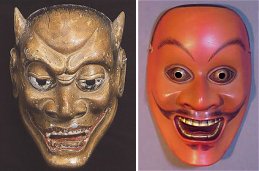
- (L) Yakan. Chinese fox-like creature that climbs trees and roars like a wolf
from shofu.pref.ishikawa.jp/shofu/geinou_e/nougaku/4e/nougaku4-c_e.html
- (R) Ko-tobide. The Fox Spirit in Noh Plays.
Mask used for the role of the fox spirit or demons in Noh Plays.
- The She-Fox of Shinoda
Kuzunoha was a vixen who turned into a beautiful woman in order to marry the man who saved her life. Later, when her young son (Seimei) glimpsed his mother's animal form, Kuzunoha was forced to abandon her family and return to the forest.

CHINESE AND VIETNAMESE FOX LEGEND
Courtesty Illuminatedlantern.com, Ghost Lovers and Fox Spirits
At the age of fifty, a fox can change into a woman. At the age of a hundred, it can change into a beautiful girl or a wizard or a man who seduces women; it can know about happenings a thousand li distant; it can bewitch people, leading them astray and causing them to lose their wits. At the age of a thousand, it can communicate with heaven and become a celestial fox.
This basic outline of the powers of a fox comes from mythologist Kuo Pu, writing as long ago as c.324 A.D. Foxes in supernatural tales vary from being vicious and murderous, to having no evil intent whatsoever. They, like ghosts, have come to be seen as amorous creatures. But even more than ghosts, foxes can lose their inhibitions and become absolutely wanton in their desires. Even today, to say a woman is "like a fox" is to call her a seductress, a whore.
A fox disguised as a woman is usually beautiful and seductive, as a man he is usually handsome, scholarly, charming, and ready for a good time. Sometimes, the transformation is not so good, in that a tail may occassionally protrude. When discovered and killed, the fox will sometimes be seen to have a human skull propped on its head, and so through that was able to use its magic to appear human.
At times, the fox behaves just as would a female ghost, seeking the companionship of a human, causing the human's ultimate decline and death, whether intended or not. And in fact, sometimes a ghost and a fox may share the same home, in that a fox family may make their nest in a tomb. Again, as with ghost stories, there is the assumption that the fox spirit, being neither human nor animal, neither living nor ghost, seeks out living humans because it desires to share in the experience of a living being.
Foxes do not fear ghosts, with whom they often have a rivalry. But they do fear dogs. Sometimes, the mere presence of a dog is enough for a fox spirit to change to its real form. Many stories end with the fox being chased down and killed by hunting dogs.
In early tales, the ascent of a fox from its simple origins to becoming a shape changer to ascending into a celestial fox was simply a matter of great age; the older the fox was, the more powerful she became. However, in the later tales of Pu Songling, this changed somewhat. Now a fox could go on being what it was, inhabiting the borderline between man and beast, or it could refine itself, through meditation, abstaining from pleasure, sex, murder, mayhem, and so on, and so eventually become immortal. Therefore, the fox becomes something of a metaphor for the Buddhist ideals of striving to improve yourself -- improvement did not come by itself, but only through hard and constant effort.
Foxes often represent the outsider, the stranger, the barbarian. The Chinese word for fox, hu, is a homophone for the word barbarian. So the improvement of the fox may also be seen as a gradual cultivation of the barbarian into things Chinese. Sometimes, as the outsider, the fox spirit seeks marriage, thus gaining respectability. The fox family may go to great lengths to achieve this.
A celestial fox is sometimes called a "nine-tailed fox," because it has just such a number of tails. The nine-tailed fox appears in mythos from all over Asia. In Vietnam, a battle between the mythic founder of the Vietnamese people, Lac Long, and a nine-tailed fox led to the creation of West Lake in Hanoi, originally called the "Sea of the Fox's Body." In Korea, the celestial fox, or Goo Mi Ho, is often of a more vicious complexion, as the fox would first horribly kill someone and eat them in order to take their form. And in Japan, the fox spirit or kitsune arrived from China during the T'ang Dyansty (there is even a Japanese legend explaining that it flew over), where it joined the native tanuki (a shape-changing badger), and became an integral part of the national folklore. It continued to develop in its own style, until the kitsune was in many ways distinct from its original Chinese descendants. Kabuki plays, Bunraku puppet theater, and Ukiyo-e woodblock prints all feature the celestial fox in one guise or another.

DAKINI ORIGINS - More Details
Below text courtesy of Esoteric Spirits
http://www.khandro.net/dakini_Japan.htm
There is not much concerning the Dakini teachings in the Buddhism of Japan, since most of the esoteric teachings brought to Japan by Kukai (a.k.a. Kobo Daishi) are of the lower tantra type, i.e. single form. That may be because Kukai left China after only two years of practice, and it may not have been not long enough for him to have received any of the higher Vajrayana teachings.
According to Kojien, the term “dakini-ten” is explained as a female demon who devours the hearts of the dead. This unbound spirit was believed to afford extraordinary powers to those engaged in the practice of "black" magic.
The White Fox
Inari are spirit or nature deities similar to the Indian yaksha. Their shrines are numerous and can be distinguished by the pair of fox statues that guard the entrance. One theory is that Inari became syncretized with dakini-ten. Dakini-ten were generally associated with Daikoku-ten (Mahakala) understood as the same as the god of the Five Cereals of Buddhism. This dakini had as its "messenger" a white fox. Worshipers offer fried soybean curd at Inari shrines, a food which is believed to be the foxes' favorite.
In Japan, then, the dakini is understood to be a fox spirit, a were-fox. At the shrine Chiba-Narita, there is a Dakiniten festival held in February.
Tamamo-no Mae is the Japanese name of a mysterious female tantric adept who at one time was the consort of an Indian king. Later, she became the concubine of Emperor Toba (1103-1156,) but she was believed to actually be a nine-tailed golden fox. When the Emperor suddenly fell sick with a serious illness, she was blamed. It is said that when her true identity was discovered, she sprang into the air and flew off to the Plain of Nasu where she was shot by the archer, Miura Kuranosuke. (Some say she was struck by the "hammer" of one of the gods.) When she fell to earth, she assumed the form of a rock subsequently known as sessho seki or the death stone, for any living thing that came into contact with it died.
" ... the play called "Tamamo no Mae asahi no tamoto" written by three playwrights for the puppet (joruri) theater and first staged in 1751. It was later revised and restaged in 1806 in Osaka, and it is the latter version that is better known today. ... a good synopsis of the play [is] in The Bunraku Handbook by Shuzaburo Hironaga, Maison des Arts Inc., Tokyo, Japan, 1976, pp. 369-373 ... .
Lady Tamamo is a nine-tailed fox who kills a young woman of the Emperor’s court, assumes her identity, and gains employment as a lady-in-waiting. She soon becomes the Emperor’s favorite concubine, but then later joins a prince who plots to dethrone the Emperor and agrees to use her supernatural powers to aid him. When the Emperor becomes ill, the chief astrologer of the court accuses her of having an evil influence and causing the illness.
Tamamo no Mae survives the trial, but later during a prayer to assist the Emperor, the astrologer cleverly uncovers her true identity. She then takes back her fox form and flees. During her escape Tamamo no Mae assumes various forms (a country girl, a masseur, a god of thunder, a man, a street girl, a courtesan, and once again Lady Tamamo).

MORE FOX LORE
|
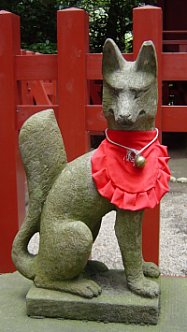
Kitsune (fox)
Oinari’s Messenger
Fox at Tsurugaoka
Hachimangu Shrine
Kamakura City
|
|
 In the Shinto realm, the fox deity known as KITSUNE is often decked in red bibs. The fox is the messenger of Oinari, the deity of food, farmers, and the rice harvest. Oinari (also written Inari) appears in both male and female form, and is generally associated with various manifestations of the Hindu goddess Dakini, who in turn is associated with Daikoku-ten (Mahakala), the latter considered the Hindu god of Five Cereals. In the Shinto realm, the fox deity known as KITSUNE is often decked in red bibs. The fox is the messenger of Oinari, the deity of food, farmers, and the rice harvest. Oinari (also written Inari) appears in both male and female form, and is generally associated with various manifestations of the Hindu goddess Dakini, who in turn is associated with Daikoku-ten (Mahakala), the latter considered the Hindu god of Five Cereals.
Here the symbolism is two-fold. First, rice is sacred in Japan, closely associated with fertility (the pregnant earth) and with sustaining life. Foxes must therefore be placated -- otherwise it would be disastrous to the livelihood of the nation’s farmers and people.
Second, the fox is associated with the concept of Kimon 鬼門 (a Japanese term stemming from Chinese geomancy; literally “demon gate”). Kimon generally means ominous direction, or taboo direction, and can be most accurately translated as "demon gate to the northeast," or the "northeast place where demons gather and enter." The fox, like the monkey, is able to ward off evil kimon, and therefore the fox, in Japan, plays the same role as the monkey in guarding the demon gate to the northeast. For the monkey, this is easy to understand. The Japanese word for monkey (猿 saru) is a homonym for the Japanese word 去る, which means to “dispel, punch out, push away, beat away," and thus monkeys are thought to dispel evil spirits. But there is no similar reason (that I know of) for the fox’s ability to ward off evil. There are approximately 20,000 Inari (fox) shrines nationwide. Characteristics of Inari shrines are red torii (gates) protected by a pair of fox statues, one on the left and one on the right. Chinese concepts of geomancy (i.e., feng shui) are discussed here.
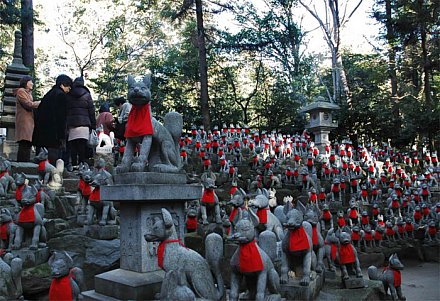
Toyokawa Inari Shrine -- Fox Statues
Photo Courtesy University of Wisconsin (Eau Claire)
Why the Red Bibs? Click here to find out.

Sōtan Kitsune (Sotan Kitsune) 宋旦狐 and Sen Sōtan 千宗旦 (1578-1658)
Below text courtesy JAANUS. A tea ceremony legend that probably dates from the first half of the 17th century. An old fox, the story goes, lived in the precinct of Shōkokuji 相国寺 in Kyoto. In the autumn he would disguise himself as the famous tea master Sen Sōtan 千宗旦 (1578-1658) and often visit tea masters in neighborhoods to drink tea and eat cakes. Everyone enjoyed the tea master's company even though all knew he was really a fox. Thus, they called him Sōtan Kitsune. The story demonstrates how well known Sōtan was in tea houses at that time. <end JAANUS quote>

LEARN MORE ABOUT THE FOX & INARI
- Color Red in Japanese Mythology (this site)
Fox in Korea (this site)
Inari Folk Lore (this site)
- WEB SITES
Inari Faith (Kokugakuin University)
Kitsune Mythology from Inari-Art.com
Shinto Rice Kami (University of Wisconsin)
Kitsune Lore (by Kit LaHaise, 1997)
Japanese Dakini (& Fox Lore) from Khandro.net
Fox Entry in Kokugakuin University Glossary; main page here
Encyclopedia Mythica, Inari Entry
Kumiho: Fox Lore from Korea by Charles La Shure
Photo Gallery of Angus Angus McIntyre
New Forms of Thirty-Six Ghosts, YOSHITOSHI TSUKIOKA
Monkeys and Foxes in Japanese Folktales (by Mr. Francis Britto
- The Obakemono Project - Fox / Kitsune Page
Gaijin's Guide to the Fantastic Folk Monsters of Japan
- FOX LORE IN ASIA academia.issendai.com/fox-index.shtml. Make sure to view this story, one of Japan’s oldest Kitsune tales. From the Nihon Ryouiki, I.2, "On Taking a Fox as a Wife and Bringing Forth a Child."
- BOOK. Japan's Fox of Mystery, Romance, and Humor by Kiyoshi Nozaki (Hokuseido Press, 1961). Out of print.
- BOOK. Animal Motifs in Asian Art: An Illustrated Guide to Their Meanings and Aesthetics.
Author Katherine M. Ball. Courier Dover Publications, 2004. (First published 1927)
- BOOK. Legend in Japanese Art, a Description of Historical Episodes, Legendary Characters, Folklore, Myths, Religious Symbolism, Illustrated in the Arts of Old Japan. By Henri L. Joly. Published 1908 by John Lane, The Bodley Head (London & New York). View this book online at the Internet Archive. View this book online at the Internet Archive.
- BOOK. Buddhism: Flammarion Iconographic Guides, by Louis Frederic, Printed in France, ISBN 2-08013-558-9, First published 1995. A highly illustrated volume, with special significance to those studying Japanese Buddhist iconography. Includes many of the myths and legends of mainland Asia as well, but its special strength is in its coverage of the Japanese tradition. Hundreds of accompanying images/photos, both B&W and color. A useful addition to your research bookshelf.
- UNFINISHED RESEARCH. Estate kami ???? I need this, right? Involves Inari I believe.
http://eos.kokugakuin.ac.jp/modules/xwords/entry.php?entryID=783
http://eos.kokugakuin.ac.jp/modules/xwords/entry.php?entryID=776
http://eos.kokugakuin.ac.jp/modules/xwords/entry.php?entryID=1083
http://eos.kokugakuin.ac.jp/modules/xwords/category.php?categoryID=6&start=20
Kōdō Temple 革堂, the 19th temple of the 33-Site Saigoku Kannon Pilgrimage
西国三十三観音霊場 sacredjapan.com
More Inari Stuff
http://www.suite101.com/content/japanese-rice-deiy-inari-okami-a196183
http://toyokawainari.jp/ 愛知県の豊川稲荷(妙厳寺;曹洞宗)の豊川荼吉尼眞天
http://en.wikipedia.org/wiki/Inari_Okami
http://eos.kokugakuin.ac.jp/modules/xwords/entry.php?entryID=783
- FAMOUS PLACE Saijō Inari 最上稲荷 (最上稲荷教総本山妙教寺法華宗)
www.inari.ne.jp/ 岡山県岡山市高松稲荷712
最上位経王大菩薩 or 最上さま
Last Update = Sept. 2011 (Added images of Sōtan Kitsune)
Last Update = Jan. 2010
|
|